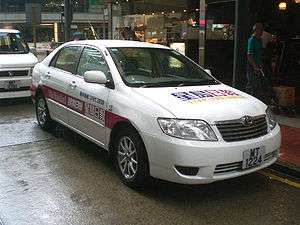Sing Tao Daily
The Sing Tao Daily (Chinese: 星島日報) also known as Sing Tao Jih Pao is Hong Kong's second largest Chinese language newspaper. It is owned by Sing Tao News Corporation Limited, of which Charles Ho Tsu Kwok (Chinese: 何柱國) is the chairman. Its English language sister paper is The Standard. The Sing Tao also maintains the news website singtao.com.
 | |
| Type | Daily newspaper |
|---|---|
| Format | Broadsheet |
| Owner(s) | Sing Tao Newspaper Group Limited |
| Founded | 1938 |
| Political alignment | Pro-Beijing (historically Pro-Taiwan) |
| Headquarters | 3 Tung Wong Road, Shau Kei Wan, Hong Kong Overseas: 188 Lafayette Street, New York City 10013, U.S. |
| Website | http://www.singtao.com http://std.stheadline.com |
| Sing Tao Daily | |||||||||||||||||||||||
|---|---|---|---|---|---|---|---|---|---|---|---|---|---|---|---|---|---|---|---|---|---|---|---|
| Traditional Chinese | 星島日報 | ||||||||||||||||||||||
| Simplified Chinese | 星岛日报 | ||||||||||||||||||||||
| |||||||||||||||||||||||
The paper has 16 overseas editions, published by nine overseas news bureaus and circulated in 100 cities in China and abroad.
History

The parent company of the Sing Tao Daily, since 2002 was Sing Tao News Corporation (and previously Sing Tao Holdings) and is based in Hong Kong. The Sing Tao Daily was first published in the same year.
After establishing its overseas base office in New York City in 1965, the Sing Tao set up International News Centres in New York, Los Angeles, San Francisco, Toronto (1978), Vancouver, Calgary, London, and Sydney. In all, the company now has twenty-two offices globally.
In 1998, members of the management team were found guilty of falsifying circulation numbers of sister newspaper The Standard. The Hong Kong government's decision not to charge the chairwoman Sally Aw for reasons of "public benefit" turned into a scandal for the Hong Kong legal system and was quoted as a reason for the million's march on 1 July 2003. Shortly after, financial problems forced Aw to sell out her stock in Sing Tao Holdings in 1999.
Sing Tao's Toronto edition is partially owned by Star Media Group, the publisher of the Toronto Star, a Torstar Corporation company.
Political stance
The Sing Tao has a long pro-government history. Before the reunification of Hong Kong with China, it supported the Kuomintang and British Hong Kong Government; and once Hong Kong was transferred of sovereignty and turned into a special administrative region, it turned support to the Beijing government.[1][2][3][4][5]
Charles Ho, chairman of Sing Tao News Corp Ltd., and his predecessor Sally Aw, were both members of the Chinese People’s Political Consultative Conference, a select group of the Chinese Communist Party’s loyal friends and allies.[6]
Chinese Communist Party influence
According to a 2013 report by Center for International Media Assistance, "The Long Shadow of Chinese Censorship: How the Communist Party’s Media Restrictions Affect News Outlets Around the World," a number of patterns emerged in recent decades that signalled Sing Tao was under influence or directly controlled by the Chinese Communist Party: management and owners began practicing “self-censorship”, “high-risk” contributors were being terminated, and high turnover rates increased as journalists left due to an “unpalatable editorial policy.”[7]
Editorial coverage also shifted noticeably since the 1990s, notes the report:
- Avoiding or limiting coverage of politically sensitive topics such as 1989 military crackdown on Tiananmen Square protesters, Tibet, and Taiwanese independence.
- Shifting critical opinions from front to back pages.
- Choosing “politically correct” rhetoric.
- Reducing investigative journalism in favor of soft news or a simple accounting of emerging events.
A 2001 report on Chinese media censorship by the Jamestown Foundation cited Sing Tao as one of four major overseas Chinese newspapers directly or indirectly controlled by Beijing.[8] “Four major Chinese newspapers are found in the U.S.—World Journal, Sing Tao Daily, Ming Pao Daily News, and The China Press," reads the report, “Of these four, three are either directly or indirectly controlled by the government of Mainland China, while the fourth (run out of Taiwan) has recently begun bowing to pressure from the Beijing government.”
The point of view on the influence of Chinese Communist Party, was also stated by another author John Manthorpe in his book Claws of the Panda.[9]
See also
- Headline Daily
- Newspapers of Hong Kong
- Media in Hong Kong
- Newspaper Society of Hong Kong
- Hong Kong Audit Bureau of Circulations
- The Standard (Hong Kong)
- Sing Tao Daily (Canada)
References
- "Sing Tao Daily". Chinese Advertising Agencies, Inc. Archived from the original on 4 March 2016. Retrieved 14 February 2014.
- "Editor Dismissed Over Pro-Beijing Edits, Say Sources". Canada Free Press. Archived from the original on 22 February 2014. Retrieved 14 February 2014.
- Yu, Jess Macy (6 October 2014). "Hong Kong Newspapers, Pro- and Anti-Beijing, Weigh In on Protests". The New York Times. Archived from the original on 11 August 2019. Retrieved 11 August 2019.
- "Beijing's 'Invisible Hand' at Work Ahead of Hong Kong Election". Radio Free Asia. 7 February 2017. Archived from the original on 12 August 2019. Retrieved 12 August 2019.
- Huang, Zheping (2 August 2016). "China is using Hong Kong's media to broadcast its smear campaigns". Quartz. Archived from the original on 13 April 2020. Retrieved 13 August 2019.
- "Archived copy". Archived from the original on 4 August 2018. Retrieved 26 May 2020.CS1 maint: archived copy as title (link)
- Cook, Sarah (22 October 2013). "The Long Shadow of Chinese Censorship: How the Communist Party's Media Restrictions Affect News Outlets Around the World" (PDF). Center for International Media Assistancee. Archived from the original (PDF) on 9 February 2014. Retrieved 1 October 2017.
- Duzhe, Mei. China Brief Vol1, Issue 10. "How China's Government is Attempting to Control Chinese Media in America" Archived 6 February 2016 at the Wayback Machine "Jamestown Foundation." 2001
- John Manthorpe (5 January 2019). Claws of the Panda: Beijing's Campaign of Influence and Intimidation in Canada. Cormorant Books. p. 171. ISBN 978-1-77086-539-6.
External links
| Wikimedia Commons has media related to Sing Tao Daily. |